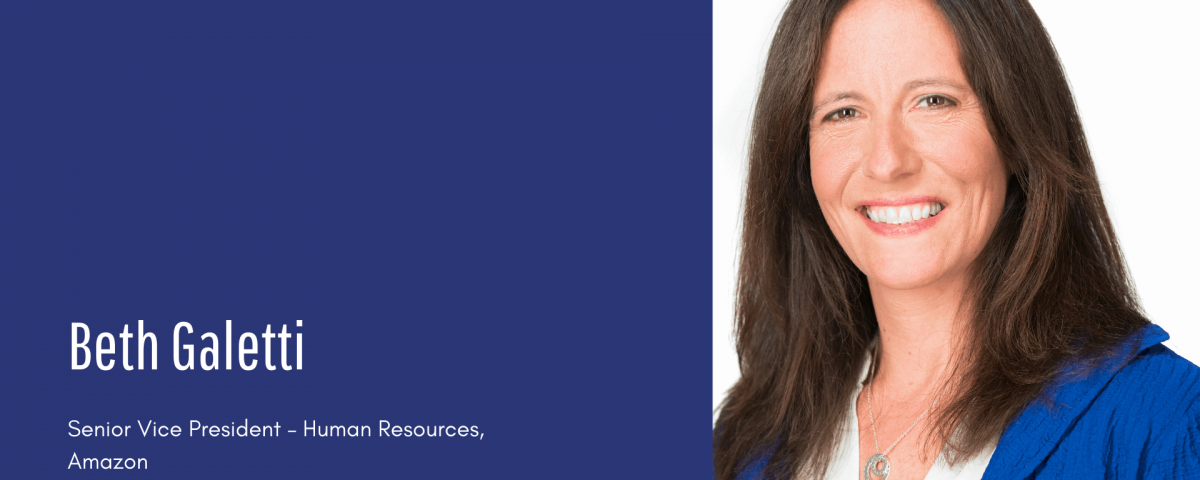- Have any questions?
- 888-432-8878
- steve@sebackground.com
As the COVID-19 crisis takes a sharp turn from government to business, the issue of redefining jobs moves up the agenda. In an interview with The HR Digest, Beth Galetti, Senior Vice President Human Resources at Amazon, explains the importance of business resource groups and the vital role it plays to deliver real business results.

The HR Digest: What is Amazon’s secret sauce for being recognized several times as “Great Place to Work?” Do you still see room for improvement in Amazon’s employment practices?
Beth Galetti: Amazon is where smart, passionate people come to obsess about customers and innovate on their behalf. Amazonians come here – and stay – because they get to do meaningful and impactful work. They have high ownership and are encouraged to invent things that have never been done before. They get to build the future.
Amazon operates like a series of customer-focused start-ups innovating at a fast pace. This very nimble organization allows Amazon employees to build their own path by owning their development, their career, and their future. The possibilities they explore, the opportunities they take advantage of, and the impact they have is driven by their ideas and initiative. In other words, your experience and trajectory at Amazon is in your hands.
In addition to our culture, which makes Amazon an incredible place to work, we also invest in our employees, help them grow their careers – both inside and outside of Amazon – and reward them for their contributions. This includes our $15 starting wage for all employees and our competitive benefits, including health insurance from the first day on the job, 401(k) partial matching, up to 20 weeks of paid parental leave, and access to free skills training for higher-paying, in-demand roles.
Employee-led resource groups (ERGs) are one of Amazon’s core strengths. Can you tell The HR Digest readers more about these programs and how they promote change within the company in practical terms?
We value individual expression, respect different opinions, and work together to create a culture where each of us is able to contribute fully. Our unique backgrounds and perspectives strengthen our ability to achieve Amazon’s mission of being Earth’s most customer-centric company.
Amazon has 12 affinity groups, also known as employee resource groups, with more than 90,000 members across 190 chapters that bring Amazonians together across businesses and locations around the world. Some examples include the Black Employee Network (BEN), Amazon Women in Engineering (AWE), and Indigenous@. These groups play an important role in building internal networks for creating a community, advising Amazon business units, leading in service projects, and reaching out to communities where Amazonians live and work.
As one of the world’s largest employers with workforce all across the globe, what are Amazon’s best practices during the crisis to ensure productivity and transparency?
The health and safety of our employees around the world has been, and continues to be, our top priority as we face the challenges associated with the coronavirus.
In 2020 alone, we created over 500,000 jobs globally and used our scale to come up with new ideas to manage the challenges posed by COVID-19. From implementing new technology to allow us to onboard all of our new employees virtually, even taking their safety training on their mobile phone before their first day on the job, to building our own COVID-19 testing labs with more than one million of our front-line employees already tested, to using AI in our fulfillment centers to ensure physical distancing is in place to protect our employees.
At Amazon, how do you see this changing the HR landscape, and what does Amazon do to stay ahead of the curve?
Employees come to Amazon to do meaningful work, and our job is to make that easier by removing barriers, fixing defects, and enabling self-service. Applying to, working at, and leaving Amazon should be frustration-free experiences. In other words, we apply the same high standards we have for customers to developing tools that allow us to recruit and retain the best talent.
For example, our employees used to have to work with their manager or HR representative to get support for things like changing their schedule, requesting time off, or checking on their pay. We make these simple, but important, tasks easier for them by building products like AtoZ – an app for an Android or iOS phone – for hundreds of thousands of hourly employees to easily check schedules, request time off, change shifts, check pay, and receive company news. Throughout the pandemic, for instance, we were able to update this app so that associates could clock in for work on their phone, allowing them not to gather at a time clock before or after a shift.
We are constantly auditing ourselves. We listen to feedback from employees on a daily basis and take quick action to fix problems and invent new ways to make their experiences better.
What do you consider your most rewarding experience in professional life?
At Amazon, we were fortunate to have the trust of our customers and be able to serve them during the COVID-19 pandemic, and I am proud to be a part of the team that demonstrated tireless dedication to ensure the health, safety and wellbeing of our more than 1.3 million employees. One of the most rewarding experiences for me this past year was building, from scratch, a COVID-19 testing lab to give frontline employees in the US and the UK the access to government-certified COVID-19 testing regularly. Early in the pandemic, our employees faced the same shortage in testing that the world faced, and we decided to try building our test labs – something we had never done before – to increase testing capacity and support our employees, who told us that they would feel safer if they could get tested regularly.
We brought a team together from across the company, from technologists, scientists and healthcare professionals, and met daily to go from idea to implementation in a matter of months. It was exciting to be in a heavy learning mode, learning about things like the biology of a virus and the variations in virus testing methodology, while we piloted different ideas to quickly build the final lab in Kentucky. When we invent at Amazon, we expect one another to work across functional boundaries, and each team member contributes their ideas regardless of their specific job title. I was proud to work alongside talented team members as we built and launched COVID-19 testing labs that have provided millions of tests for employees to date – and counting.
How are you going to shake things up next?
To manage the challenges of 2020, we doubled down on the things that matter most to our employees and their communities: workplace safety, customer obsession, diversity, and sustainability. These will continue to be our core focus areas, but it’s critical for the HR function to continue to evolve to deliver the biggest impact. At Amazon, we recently renamed our HR organization to People Experience and Technology (PXT for short) to signify that we seek to deliver the best experience for all Amazonians, and are innovators and builders ourselves—building the workplace for Amazonians to invent on behalf of customers.
Looking ahead, we will focus on three things. First, continuing to invest in technology and tech teams that can develop tools for our employees. The People Experience and Technology organization includes over 1,000 tech employees—including dedicated engineers, computer scientists, and product managers—who develop world-class, easy, and intuitive products for candidates and employees. Second, launching new egalitarian benefits like Amazon Care, which starting this summer will offer Amazon employees in the U.S. access to a medical professional from their phone in less than 60 seconds, or Neighborhood Health Centers, clinics either on-site of our facilities or in the vicinity exclusively reserved for our employees and their families. And lastly, building mechanisms that allow us to preserve our culture as we scale with HR innovations like Connections, a tool that helps us gather employee feedback in real-time, every day.
The post Creating a Culture of Quality: An Interview with Beth Galetti appeared first on The HR Digest.
Source: New feed






